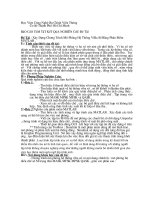Các mô hình hệ thống của kỹ thuật phần mềm
Bạn đang xem bản rút gọn của tài liệu. Xem và tải ngay bản đầy đủ của tài liệu tại đây (1.2 MB, 45 trang )
System models
(Bài 5: Các Mô hình Hệ thống)
Slide bài giảng
• Từ bài này slide bài giảng để nguyên tiếng Anh
– Sinh viên hỏi trên lớp nếu có phần nào chưa hiểu
– Có thể dùng diễn đàn môn học để trao đổi
Objectives
• To explain why the context of a system should
be modelled as part of the RE process
• To describe behavioural modelling, data
modelling and object modelling
modelling and object modelling
• To introduce some of the notations used in
the Unified Modeling Language (UML)
• To show how CASE workbenches support
system modelling
Content
• Context models
• Behavioural models
• Data models
•
Object models
•
Object models
• CASE workbenches
System modelling
• System modelling helps the analyst to understand
the functionality of the system
– Models are used to communicate with customers.
Multiple models
• Different models present the system from different
perspectives
– External perspective showing the system’s context or
environment;
•
Represent all external entities that may interact with a system.
•
Represent all external entities that may interact with a system.
– Behavioural perspective showing the behaviour of the
system;
• Internal working of system’s elements
– Structural perspective showing the system or data
architecture
• Elements and their relationships
Model types
• Data processing model showing how the data is
processed at different stages.
• Composition model showing how entities are
composed of other entities.
composed of other entities.
• Architectural model showing principal sub-systems.
• Classification model showing how entities have
common characteristics.
• Stimulus/response model showing the system’s
reaction to events.
Context models
• Context models are used to illustrate the
operational context of a system –
– Show what lies outside the system boundaries
•
Social and organisational concerns may affect
•
Social and organisational concerns may affect
the decision on where to position system
boundaries
• Architectural models show the system and its
relationship with other systems.
The context of an ATM system
ATM systemATM system
Account DB
Branch
system
Branch
Accounting
system
Branch
Branch
Security
system
– Does not show physical locations, how they are
connected, how data is moving around
Usage DB
system
Branch
counter
system
Mantainance
system
Process models
• Process (tiến trình) models show the overall
process and the processes that are supported
by the system.
•
Data flow
(
luồng
dữ
liệu
) models may be used
•
Data flow
(
luồng
dữ
liệu
) models may be used
to show the processes and the flow of
information from one process to another.
Equipment procurement process
Get cost
estimates
Accept
delivery of
equipment
Check
delivered
items
Validate
specification
Specify
equipment
required
Equipment
spec.
Checked
spec.
Delivery
note
Delivery
note
Order
notification
Installation
instructions
Spec. +
supplier +
estimate
Supplier list
Equipment
spec.
Choose
supplier
Place
equipment
order
Install
equipment
Find
suppliers
Supplier
database
Accept
delivered
equipment
Equipment
database
Installation
acceptance
Equipment
details
Checked and
signed order form
Order
details plus
blank order
form
Supplier list
spec.
Behavioural models
• Used to describe the overall behaviour of a
system
• Two types of behavioural model:
–
Data processing
models that show how data is
–
Data processing
models that show how data is
processed as it moves through the system;
– State machine models that show the systems
response to events.
• Both of them are required to describe the
system’s behaviour
Data-processing models
• Data flow diagrams (DFDs) may be used to model the
system’s data processing.
• These show the processing steps as data flows
through a system.
through a system.
• DFDs are an intrinsic part of many analysis methods.
– Widely used
• Simple and intuitive notation that customers can
understand.
• Show end-to-end processing of data.
Example: Order processing DFD
Complete
order form
Validate
order
Record
order
Send to
supplier
Order details +
blank order form
Signed form
Checked
and signed
order +
order
notification
order form
order
order
Adjust available
budget
Filled form Signed form
Order
file
Budget
Budget
file
Signed form
Order details Order amount +
account details
Data flow diagrams
• Model the system from a functional
perspective.
• Tracking and documenting how the data
associated with a process
associated with a process
– Helpful to develop an overall understanding of the
system.
• May be used to show the data exchange
between a system and other systems
Example: Insulin pump DFD
Blood sugar
sensor
Blood sugar
analysis
Insulin
requirement
Blood
Blood
parameters
Blood sugar level
requirement
computation
Insulin
delivary
controller
Insulin
requirement
Insulin
Pup control
commands
Insulin
pump
State machine models/Statecharts
• Model the behaviour of the system in
response to external and internal events.
• Show the system’s responses to stimuli so are
often used for modelling
real
-
time
systems.
often used for modelling
real
-
time
systems.
• Show system states as nodes and events as
arcs between these nodes.
– When an event occurs, the system moves from
one state to another.
Statecharts
• Allow the decomposition of a model into sub-
models (see following slide)
• A brief description of the actions is included
following the ‘
do
’ in each state
following the ‘
do
’ in each state
• Can be complemented by tables describing
the states and the stimuli
• Are an integral part of the UML
Microwave oven statechart
Full power
do:
operate
Full
power
Full
po
w
er
Number
do: set power
= 600
Set time
do: get number
Operation
Waiting
do: display
time
Timer
Enabled
do:
operate
oven
Half
power
Half
power
po
w
er
Door
open
Door
closed
Door
closed
Door
open
Start
Half power
do: set power
= 300
do: get number
exit: set time
Disabled
Cancel
Waiting
do: display
time
time
do: display
'Ready'
do: display
'Waiting'
Timer
Microwave oven state description
State Description
Waiting The oven is waiting for input. The display shows the current time.
Half power The oven power is set to 300 watts. The display shows ‘Half power’.
Full power The oven power is set to 600 watts. The display shows ‘Full power’.
Set
time
The
cooking
time
is
set
to
the
user’s
input
value
.
The
display
shows
the
Set
time
The
cooking
time
is
set
to
the
user’s
input
value
.
The
display
shows
the
cooking time selected and is updated as the time is set.
Disabled
Oven operation is disabled for safety. Interior oven light is on. Display
shows ‘Not ready’.
Enabled
Oven operation is enabled. Interior oven light is off. Display shows
‘Ready to cook’.
Operation
Oven in operation. Interior oven light is on. Display shows the timer
countdown. On completion of cooking, the buzzer is sounded for 5
seconds. Oven light is on. Display shows ‘Cooking complete’ while
buzzer is sounding.
Microwave oven stimuli
Stimulus Description
Half power The user has pressed the half power button
Full power The user has pressed the full power button
Timer
The
user
has
pressed
one
of
the
timer
buttons
Timer
The
user
has
pressed
one
of
the
timer
buttons
Number The user has pressed a numeric key
Door open The oven door switch is not closed
Door closed The oven door switch is closed
Start The user has pressed the start button
Cancel The user has pressed the cancel button
Data models
• Used to describe the logical structure of data
processed by the system.
• An entity-relation-attribute model sets out the
entities in the system, the relationships between
entities in the system, the relationships between
these entities and the entity attributes
• Widely used in database design. Can readily be
implemented using relational databases.
• No specific notation provided in the UML but objects
and associations can be used.
LIBSYS data model
Data dictionaries
• Data dictionaries are lists of all of the names used
– Also include descriptions of the entities, relationships and
attributes
• Advantages
– Support name management and avoid duplication;
– Store of organisational knowledge linking analysis, design
and implementation
• Many CASE workbenches support data dictionaries.
Data dictionary example
Name Description Type Date
Article Details of the published article that may be
ordered by people using LIBSYS.
Entity 30.12.2002
authors The names of the authors of the article
who
may
be
due
a
share
of
the
fee
.
Attribute 30.12.2002
who
may
be
due
a
share
of
the
fee
.
Buyer The person or organisation that orders a
copy of the article.
Entity 30.12.2002
fee-
payable-to
A 1:1 relationship between Article and the
Copyright Agency who should be paid the
copyright fee.
Relation 29.12.2002
Address
(Buyer)
The address of the buyer. This is used to
any paper billing information that is
required.
Attribute 31.12.2002









